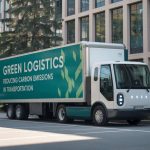Introduction to Sustainable Urban Freight Transportation
As cities worldwide continue to expand, the demand for efficient and sustainable urban freight transportation solutions has become increasingly critical. Urban freight transport plays a crucial role in the distribution of goods within city environments, impacting economic growth, public health, and overall quality of life. However, traditional freight transportation methods can exacerbate traffic congestion, increase greenhouse gas emissions, and degrade urban air quality. This article explores the latest trends and technologies in sustainable urban freight transportation, providing insights into how cities can achieve more eco-friendly logistics.
Current Challenges in Urban Freight Transportation
The movement of goods within urban areas often presents several challenges, including:
- Traffic Congestion: Urban areas are plagued by traffic jams, slowing down the delivery of goods and increasing fuel consumption.
- Environmental Impact: Traditional freight vehicles contribute significantly to air pollution and greenhouse gas emissions, negatively affecting public health.
- Noise Pollution: The constant movement of freight vehicles generates noise pollution, affecting the quality of life for city residents.
- Infrastructure Limitations: Many urban areas are not designed to handle the increased load of freight traffic, lacking sufficient parking, loading, and unloading zones.
Emerging Trends in Sustainable Urban Freight Transportation
To address these challenges, several trends are emerging in the field of sustainable urban freight transportation:
Electric Freight Vehicles
One of the most significant trends in sustainable logistics is the adoption of electric freight vehicles. These vehicles produce zero tailpipe emissions, reducing air pollution and greenhouse gas emissions. Advances in battery technology are extending the range and payload capabilities of electric trucks, making them a viable alternative to traditional diesel-powered vehicles.
Micro-Hubs and Consolidation Centers
Micro-hubs and consolidation centers are small distribution facilities located within urban areas. They allow for the aggregation of shipments from various sources, which can then be delivered to their final destinations using eco-friendly vehicles like cargo bikes or electric vans. These hubs help reduce the number of vehicles required for deliveries, thereby decreasing traffic congestion and emissions.
Urban Consolidation Centers
Urban consolidation centers (UCCs) are facilities where goods destined for urban areas are grouped and reorganized for final delivery. By consolidating shipments, UCCs can reduce the number of delivery vehicles entering city centers, easing traffic congestion and reducing emissions.
Drone Deliveries
Drone technology is rapidly advancing, offering a futuristic approach to urban freight transportation. Drones can bypass traffic congestion by flying directly to their delivery points, reducing delivery times and emissions. Although regulatory hurdles and technical challenges remain, the potential for drone deliveries to revolutionize urban logistics is immense.
Autonomous Delivery Vehicles
Self-driving technology is making its way into urban freight transportation. Autonomous delivery vehicles can operate efficiently without human intervention, optimizing delivery routes and reducing operational costs. These vehicles are typically electric, further contributing to sustainability goals.
Eco-Friendly Packaging
Sustainable urban freight transportation also extends to the packaging used in deliveries. Eco-friendly packaging options, such as biodegradable materials and reusable containers, can significantly reduce the environmental impact of urban logistics. Companies are increasingly adopting these practices to minimize waste and enhance sustainability.
Technologies Driving Sustainable Urban Freight Transportation
Several cutting-edge technologies are driving the transformation of urban freight transportation towards sustainability:
Internet of Things (IoT)
The Internet of Things (IoT) enables the real-time tracking and monitoring of freight vehicles and shipments. IoT devices can provide valuable data on vehicle performance, traffic conditions, and delivery status, allowing for optimized route planning and increased operational efficiency. This technology helps reduce fuel consumption and emissions by minimizing idle times and ensuring timely deliveries.
Artificial Intelligence (AI) and Machine Learning
AI and machine learning algorithms can analyze vast amounts of data to optimize urban freight logistics. These technologies can predict demand patterns, suggest efficient delivery routes, and improve inventory management. By enhancing operational efficiency, AI and machine learning contribute to reducing the environmental impact of urban freight transportation.
Big Data Analytics
Big data analytics involves the processing and analysis of large datasets to uncover insights and trends. In urban freight transportation, big data can help identify traffic congestion patterns, optimize delivery schedules, and reduce operational inefficiencies. This data-driven approach supports sustainable practices by minimizing fuel consumption and emissions.
Telematics Systems
Telematics systems combine GPS technology, onboard diagnostics, and telecommunication capabilities to monitor and manage vehicles. These systems provide real-time information on vehicle location, speed, and condition, enabling fleet managers to make informed decisions and optimize routes. Telematics systems contribute to sustainability by reducing fuel consumption and improving vehicle utilization.
Blockchain Technology
Blockchain technology offers a secure and transparent way to track the movement of goods throughout the supply chain. By providing a tamper-proof record of transactions and deliveries, blockchain can enhance traceability and accountability in urban freight transportation. This technology can also improve coordination between different stakeholders, ensuring more efficient and sustainable logistics.
Collaborative Platforms
Collaborative platforms facilitate communication and cooperation between various players in the urban freight transportation ecosystem. These platforms enable the sharing of resources, such as vehicles and storage space, leading to better utilization and reduced environmental impact. By fostering collaboration, these platforms help create a more cohesive and sustainable urban logistics network.
Case Studies of Sustainable Urban Freight Initiatives
Several cities around the world are leading the way in implementing sustainable urban freight transportation solutions. Here are a few notable examples:
Amsterdam, Netherlands
Amsterdam is a pioneer in sustainable urban logistics. The city has implemented initiatives such as the « Green Deal Zero Emission City Logistics, » which aims to achieve zero emissions in urban freight transport by 2025. The city promotes the use of electric cargo bikes and electric trucks, along with the establishment of consolidation centers to streamline deliveries.
London, United Kingdom
London has introduced various measures to make urban freight transportation more sustainable. The city’s Ultra Low Emission Zone (ULEZ) restricts access to high-polluting vehicles, encouraging the use of cleaner alternatives. Additionally, the London Freight Plan emphasizes the importance of consolidation centers and the adoption of electric freight vehicles to reduce emissions and traffic congestion.
New York City, USA
New York City is exploring innovative solutions to address its urban freight challenges. The city has launched initiatives such as « Clean Fleet NYC, » which aims to transition the city’s fleet to electric and low-emission vehicles. Additionally, NYC is piloting the use of drones for last-mile deliveries and promoting the establishment of micro-distribution centers to support sustainable logistics.
Future Directions for Sustainable Urban Freight Transportation
As urbanization continues to rise, the need for sustainable urban freight transportation will become even more crucial. Looking ahead, several key directions can shape the future of this field:
Integrated Transportation Systems
The integration of various transportation modes, including public transit, bicycling, and walking, with urban freight logistics can create a more efficient and sustainable system. This approach reduces the reliance on traditional delivery trucks, contributing to lower emissions and improved traffic flow.
Dynamic Routing and Scheduling
Advances in technology can enable dynamic routing and scheduling of freight deliveries based on real-time data. By adapting to current traffic conditions and demand patterns, logistics companies can enhance efficiency, reduce fuel consumption, and minimize emissions.
Investment in Infrastructure
Investing in urban infrastructure that supports sustainable freight transportation is essential. This includes the development of dedicated loading and unloading zones, charging stations for electric vehicles, and smart traffic management systems to optimize the flow of goods.
Policy and Regulation
Policy frameworks and regulations play a crucial role in promoting sustainable urban freight transportation. Governments can incentivize the adoption of green technologies, enforce emission standards, and encourage collaboration between public and private stakeholders to achieve sustainability goals.
Community Engagement
Engaging with local communities and stakeholders is vital to the success of sustainable urban freight initiatives. By including residents, businesses, and policymakers in the decision-making process, cities can develop solutions that address specific needs and gain public support for sustainable practices.
Conclusion
Sustainable urban freight transportation is essential for creating livable, healthy, and economically vibrant cities. By adopting innovative trends and technologies, such as electric vehicles, consolidation centers, and advanced data analytics, cities can tackle the challenges of urban logistics and move towards a more sustainable future. Through collaborative efforts and strategic investments, the vision of efficient, eco-friendly urban freight transportation can become a reality, benefiting both current and future generations.



